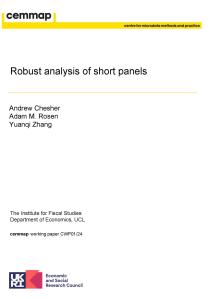In a single year, 64% of individuals in the UK pay more in taxes than they receive in social security. But most individuals experience considerable change over their lifetimes: for example those not in paid work in one year are often in work in another year. New analysis, published by the Institute for Fiscal Studies (IFS) today, shows that extending the period of analysis from a single year to an entire lifetime increases the percentage who pay more in taxes than they receive in social security to 93%.
A second key finding is that in-work benefits are just as good as out-of-work benefits at targeting the lifetime poor (those with lowest incomes over the course of a lifetime). Since in-work benefits do this without worsening work incentives by nearly so much, policymakers might want to put greater weight on in-work than out-of-work support.
These are among the main findings of a new IFS report, Redistribution from a Lifetime Perspective, using data on the baby-boom generation (born 1945–54). The study was funded by the Nuffield Foundation and co-funded by the European Research Council. The research looks at how taking a lifetime – rather than a single-year snapshot – perspective changes our view of inequality, redistribution and reforms to the tax and benefit system.
Key findings on the redistribution achieved by the current tax and benefit system include:
- Taking adult life as a whole, 93% of individuals pay more in taxes than they receive in social security. This compares with 64% of individuals when measured in a single year. These figures include most personal taxes and benefits, but do not take into account ‘business taxes’ or the benefits from public service spending.
- More than half of the redistribution achieved by taxes and benefits is effectively across periods of life rather than between different people, in the sense that the tax and benefit system takes from an individual at one age and gives back to the same individual at another.
- Income inequality is much lower from a lifetime perspective than a single-year perspective. The Gini coefficient – a common measure of inequality – for gross income is 0.49 in a single year compared with 0.28 across the whole of adult life. This indicates that a lot of the inequality between individuals is temporary in nature, reflecting either the stage of life they are at or some short-lived shock to income, such as a period of unemployment.
- The tax and benefit system is less effective at reducing inequality over the lifetime than within each year. In the single-year snapshot, the tax and benefit system reduces the Gini coefficient by 31% but over the lifetime only by 15%. This is because much of what it takes at one age is returned to the same individual at another age. Its effectiveness at targeting lifetime outcomes is limited by the fact that most taxes and benefits are assessed over periods of a year or less, making the targeting of outcomes over short horizons much easier than over longer horizons.
The analysis of the distributional effects of historical tax and benefit reforms shows:
- The Labour government’s expansion of in- and out-of-work benefits between 1999 and 2002 was less well targeted towards the lifetime poor than the snapshot poor. The reason is that many of the poorest individuals over the lifetime are not poor in all periods of life.
- The losses from tax and benefit reforms implemented by the Conservative-Liberal Democrat coalition between 2010 and 2015 are more evenly spread across the income distribution from a lifetime perspective than in a snapshot. However, the reforms still take proportionally more from the poorest half of individuals. While in a single year upper-middle income groups were largely protected from the reforms, over their lifetime these individuals will sometimes be in receipt of benefits (and so will lose from the benefit cuts) and sometimes have high levels of earnings (and so will be affected by the income tax and National Insurance increases).
- The four-year freeze to working-age benefits and tax credit cuts announced in the July 2015 budget remain regressive from a lifetime perspective, but losses extend into the top half of the distribution. This is because many individuals quite high up the lifetime income distribution will claim these benefits at some point in their lives (if only briefly), while the lifetime poor are not always in receipt of affected benefit payments.
The report also analyses the distributional effects of hypothetical tax and benefit reforms:
- In-work (i.e. work contingent) benefits are just as good at targeting the lifetime poor as out-of-work benefits, but do so without worsening work incentives by nearly so much. The reason for this is that the lifetime poor spend the majority of their working lives in paid work. As a result, policymakers looking to target the lifetime poor might favour doing so through in-work benefits. However, in-work benefits may not be as good as out-of-work benefits at addressing temporary hardship.
- Changes to the higher rate of income tax do target the lifetime rich reasonably well. This is because rich individuals tend to remain rich over prolonged periods of time.
- From a lifetime perspective, increasing the main rate of VAT looks close to neutral in distributional terms. This stands in contrast to a snapshot perspective, from which increases in the main rate of VAT look regressive. This arises because snapshot-poor individuals typically spend a lot relative to their income, and therefore pay a lot of VAT, but the same is not true of the lifetime poor.
- Increases in VAT on zero- and reduced-rated goods are mildly regressive from a lifetime perspective. This is because the lifetime poor spend a greater share of their income on zero- and reduced-rated goods, like food and heating. However, it is possible to design a reform package eliminating zero- and reduced-rating that pays for itself and is distributionally neutral. As a result, it is hard to justify zero- and reduced-rating on distributional grounds.
“Understanding the lifetime impact of policies matters because individuals experience considerable changes in their circumstances over their lives,” said Peter Levell, a Research Economist at the IFS, and an author of the report. “While over a third of individuals receive more in social security than they pay in taxes in a single year, this is true for very few when you look over an entire lifetime.”
Barra Roantree, a Research Economist at the IFS and another author of the report, said: “The sharp distinction often made in policy debates between ‘working’ and ‘non-working’ families is not especially useful: in reality very few individuals are permanently out of work, the poor are not always poor and, albeit to a lesser extent, the rich are not always rich.”
“The existing tax and benefit system, assessed largely against circumstances in the current year, doesn’t do especially well at redistributing resources towards the lifetime poor. Targeting lifetime redistribution more effectively may require new policies that take longer-run circumstances into account,” said Jonathan Shaw, a Senior Research Economist at the IFS, and the third author of the report.
ENDS
Notes to Editors:
1. A launch event for the IFS report is to be held at 10.00 on Tuesday 22 September at the Nuffield Foundation, 28 Bedford Square, London WC1B 3JS. http://www.ifs.org.uk/events/1192
2. The report Redistribution from a Lifetime Perspective by Peter Levell, Barra Roantree and Jonathan Shaw is to be published and is under embargo until 00.01 UK time on Tuesday 22 September 2015.
3. The authors are very grateful for financial support from the Nuffield Foundation for the project ‘Redistribution and insurance across the lifecycle – the effects of the UK tax and benefit system.’ Co-funding from the European Research Council and the ESRC-funded Centre for the Microeconomic Analysis of Public Policy at the IFS is also very gratefully acknowledged.
4. The Nuffield Foundation is an endowed charitable trust that aims to improve social well-being in the widest sense. It funds research and innovation in education and social policy and also works to build capacity in education, science and social science research. The Nuffield Foundation has funded this project, but the views expressed are those of the authors and not necessarily those of the Foundation. More information is available at www.nuffieldfoundation.org











